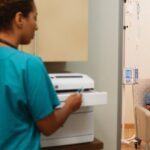Nordics and the U.K. set standards for sustainable procurement
To fight against climate change, Norwegian health authorities have committed to a 40% reduction in CO2 emissions by 2030 and they are working to become carbon neutral by 20451.
One way to help meet these targets is the “Nordic Criteria for More Sustainable Packaging: For Healthcare Products2.” This document aims to help reduce waste, increase recycling and expand the use of recycled or renewable materials3. These criteria were developed with the procurement departments at hospitals in Norway, Sweden, Denmark, Iceland and the Faroe Islands2. They are designed to be used in public tenders3. A decision tree is included to help guide packaging-related procurement decisions3.
More on this topic: The ins and outs of syringe waste disposal
Sustainable procurement transforms U.K. medical plastics
While over in the United Kingdom, the National Health Service (NHS) has pledged to reach net zero greenhouse gas emissions by 20404. Efforts to meet this target have been laid out in a report called, “Delivering a ‘Net Zero’ National Health Service4.” The NHS plans to implement decarbonisation measures in the following areas: estate and facilities, travel and transport, supply chain, medicines as well as research, innovation and offsetting4.
In U.K. hospitals, more than 1.4% of supply chain emissions come from single-use plastics4. Before the pandemic, these hospitals produced an estimated average of 11,300 tonnes of plastic waste per day5. Better resource management could result in a 10% reduction in clinical single-use plastics (e.g., syringes, intravenous catheters or disinfecting caps), leading to a savings of 224 kilotonnes of carbon dioxide equivalent (ktCO2e)4.
As part of efforts to decarbonise their supply chain, they will require non-pharmaceutical suppliers to meet NHS commitments to reduce greenhouse gas emissions4. The U.K. NHS is actively working with suppliers to reduce emissions from medical device packaging4.
More on this topic: 3 ways that BD is fighting climate change
Sustainable procurement has the potential to change healthcare across Europe
According to Susanne Backer, Senior Consultant from the Central Denmark region, the goal of the “Nordic Criteria for More Sustainable Packaging: For Healthcare Products” is for them to eventually be adopted by European Union (EU) member states outside the Nordic nations3.
With close to €2 trillion spent each year by public authorities (many in healthcare) in the EU6, public procurement has the potential to shape a more sustainable economy7. An estimated 8.3% of gross domestic product (GDP) is used to purchase health services and medical goods in the EU8.
Procurement professionals and healthcare administrators across our region can help reduce their healthcare facilities’ environmental impact through sustainable procurement9.
Want to know how you can make your tendering process more sustainable? Take a look at the European Commission’s Buying green! handbook below.
References
- Hayes B. Oppdragsdokument. Oslo, Norway: Sykehusinnkjøp HF; 2022.
- Nordic Criteria for More Sustainable Packaging: For Healthcare Products. Danish Regions. Published March 1, 2022. Accessed February 9, 2023. https://sykehusinnkjop.no/Documents/Om%20oss/Samfunnsansvar/Final%20version%20of%20nordic%20criteria%20for%20more%20sustainable%20packaging%20ver%2011.pdf#:~:text=These%20Nordic%20Criteria%20for%20More%20Sustainable%20Packaging%20for,that%20can%20be%20used%20in%20the%20tender%20process.
- Sookne K. New Nordic Sustainability Criteria Poised to Expand in Europe. Packaging World. Published online June 23, 2022. Accessed February 9, 2023. https://www.packworld.com/news/sustainability/article/22288835/new-nordic-sustainability-criteria-poised-to-expand-in-europe#:~:text=Sustainability%20New%20Nordic%20Sustainability%20Criteria%20Poised%20to%20Expand,increasing%20the%20usage%20of%20recycled%20or%20renewable%20materials.
- Delivering a ‘Net Zero’ National Health Service. NHS England. Published July 4, 2022. Accessed February 9, 2023. https://www.england.nhs.uk/greenernhs/publication/delivering-a-net-zero-national-health-service/
- Gamba A, Napierska D, Zotinca A. Measuring and Reducing Plastics: In the Healthcare Sector. Healthcare Without Harm (HCWH) Europe; 2021. https://noharm-europe.org/sites/default/files/documents-files/6886/2021-09-23_Measuring-and-reducing-plastics-in-the-healthcare-sector.pdf
- García-Altés A, McKee M, Siciliani L, et al. Understanding public procurement within the health sector: a priority in a post-COVID-19 world. Health Econ Policy Law. Published online July 27, 2022:1-14. doi:10.1017/S1744133122000184
- European Commission. COMMUNICATION FROM THE COMMISSION TO THE EUROPEAN PARLIAMENT, THE COUNCIL, THE EUROPEAN ECONOMIC AND SOCIAL COMMITTEE AND THE COMMITTEE OF THE REGIONS: Making Public Procurement work in and for Europe. Published online October 3, 2017. Accessed February 9, 2023. https://ec.europa.eu/docsroom/documents/25612
- European Commission. PUBLIC PROCUREMENT IN HEALTHCARE SYSTEMS: Fact sheet accompanying the Opinion by the Expert Panel on Effective Ways of Investing in Health (EXPH). Published May 18, 2021. Accessed February 13, 2023. https://hadea.ec.europa.eu/news/factsheet-public-procurement-healthcare-systems-2021-05-18_en
- Buying green! A handbook on green public procurement. European Commission. Published April 1, 2016. Accessed February 13, 2023. https://ec.europa.eu/environment/gpp/buying_handbook_en.htm
This list of references to third-party peer-reviewed material and the sites they are hosted on are provided for your reference and convenience only, and do not imply any review or endorsement of the material or any association with their operators. The Third-Party References (and the Web sites to which they link) may contain information that is inaccurate, incomplete, or outdated. Your access and use of the Third Party Sites (and any Web sites to which they link) is solely at your own risk.
BD-83632




